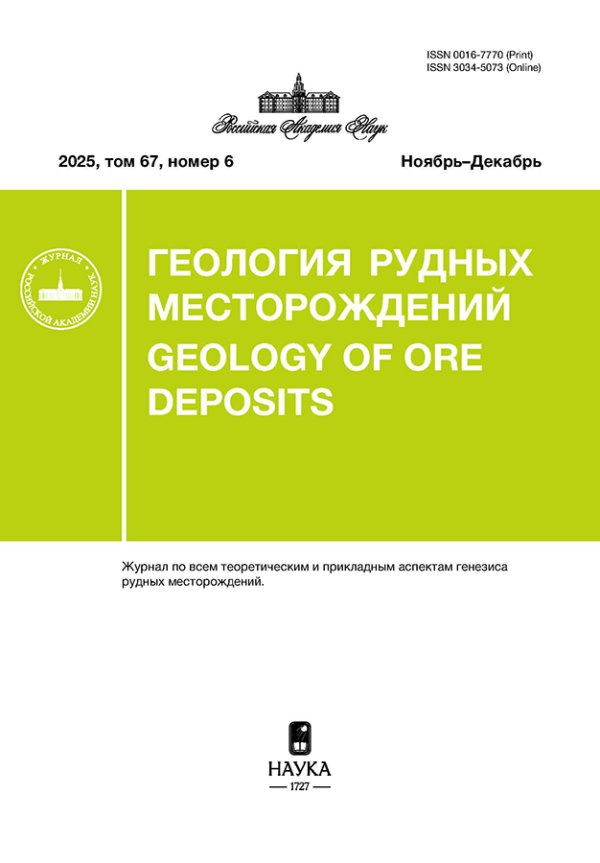Vol 65, No 3 (2023)
Articles
Classification of Polymetallic Ore-Forming Processes and Transitional VMS–SEDEX–MV-type: the Example of the Giant Ozernoe Deposit in Transbaikalia, Russia
Abstract
This article discusses the general classification approaches and key features of different families of polymetallic deposits, with particular attention to the largest in Eurasia Ozernoe polymetallic deposit located in Western Transbaikalia and thoroughly explored 50 years ago. The main groups (or families) of polymetallic deposits in the English-language literature are identified by brief names: volcanogenic massive sulphide (VMS), sedimentary exhalative (SEDEX), and Mississippi Valley type (MVT). Within these three families of deposits, there are many additional types/subtypes, a large number of which are mostly due to the incompleteness and inconsistency of accumulated knowledge on the genesis of polymetallic deposits. Overall, all Pb–Zn(Ag,Cu) deposits—both those that are considered syngenetic, forming on and near the seafloor (VMS and SEDEX), and epigenetic low-temperature ones (MVT)—demonstrate a wide range of features that distinguish and bring together these families. This also applies to the types and subtypes of mineral deposits identified within them. One of the most complex objects for geological–genetic classification is the Ozernoe deposit studied by the authors, which, in terms of the nature of the host rocks, is intermediate between the end members of all three families: SEDEX, VMS and MVT. The deposit is localized in volcanic–carbonate–terrigenous rocks of the Cambrian Oldynda formation, but the age and stratigraphic affiliation of the ore-bearing series remain a matter of debate. The Ozernoe deposit is a combination of massive sulfide and siderite ore beds, ore breccia horizons, low-carbonate aleuropelite members, limestones, fine detrital tuffites, lavas, and tuffs. The sulfide bodies are confined to several stratigraphic levels, and the main productive unit thickness reaches 230 m. The thickness is comprised of 12 mineral lodes, a series of stratified ore bodies separated by gangue layers of sedimentary and volcaniclastic rocks. The primary ore minerals are pyrite, sphalerite, and galena, while the minor minerals include magnetite, chalcopyrite, marcasite, tetrahedrite, and arsenopyrite. There are two main theories regarding the origin of the ore: volcanogenic–sedimentary and hydrothermal–metasomatic. The hydrothermal–sedimentary theory remains the prevailing hypothesis, but there are many indications that epigenetic hydrothermal–metasomatic and dynamic metamorphic processes have contributed to the formation of the deposit. These include the appearance of sulfide–quartz and quartz–carbonate–sulfide veins and vein zones in fine-grained “layered” ores, with large crystalline sphalerite and galena; multiple signs of ore recrystallization, including the formation of pyrite porphyroblasts and arsenopyrite metacrystals; and the formation of solid pyrrhotite and pyrrhotite–magnetite ores with a lenticular-striped, gneissic structure. These observations suggest that different processes, both hydrothermal–sedimentary and metamorphogenetic–metasomatic, were involved in the formation of the Ozernoe deposit. In other words, primary hydrothermal–sedimentary ores were redeposited by late hydrothermal solutions. Nevertheless, many issues concerning the genesis of the Ozernoe deposit remain unresolved.
 201-236
201-236


THE WORLD’S LARGEST FOUTA DJALLON–MANDINGO BAUXITE PROVINCE (WEST AFRICA): PART 4. THE MECHANISM OF ZONING FORMATION IN LATERITE BOXITE-BEARING WEATHERING CRUSTS
Abstract
Obtained as a result of detailed exploration and year-round observations of the hydrogeological regime at large deposits, as well as special hydrochemical studies of various types of water and changes in the gas composition of the underground atmosphere in the lateritic weathering crust of the largest bauxite-bearing province FDM, thanks to a reliable factual base, allowed us to draw a number of important conclusions on the conditions and features of the formation of zoning in the lateritic weathering profile for the first time. The weathering profile consists of two metasomatic columns spatially combined in plan, but vertically separated: the upper, lateritic cover, composed mainly of the products of the final hydrolysis of lateritic weathering, that is, hydroxides and oxides of iron and aluminum; the lower one, composed of clayey eluvium, products of hydration and decomposition of aluminosilicates - polymineral clays and kaolinite. In both columns, the processes of changing begin with the same rainwater, but differ in hydrodynamic parameters in each of the columns. Changes in the weathering profile occur in accordance with the main patterns of low-temperature infiltration metasomatism. The modern hydrogeological and gas regime in the bauxite-bearing lateritic covers controls the mineralogical and geochemical zoning. Peculiarities of biological and soil processes, hydrodynamics and hydrochemistry in the weathering profile lead to the threshold nature of the change in physicochemical and biochemical conditions, providing the action of geochemical (oxidative, reducing, gley, adsorption) barriers - the main mechanism of zonal distribution of matter in lateritic crusts.
 237-253
237-253


Redox conditions of formation of the Priiskovy massif rock and their metallogenic consequences (South Sikhote-Alin, Primorye)
Abstract
The same Cenomanian (96.91 ± 0.88 and 96.5 ± 1.2 Ma) age of amphibole granodiorites of the magnetite and ilmenite series in the southern part of the Priiskovy massif has been established. Among the relatively homogeneous central ilmenite zone of the Sikhote-Alin orogenic belt, the local occurrence of magnetite rocks of the Priiskovy massif explains the distribution of deposits and ore occurrences of the studied site. All deposits and ore occurrences of tin within the boundaries of the Priiskovy massif are located in the zone of distribution of rocks of the ilmenite series (reducing conditions), and deposits and placers of gold and manifestations of polymetallic mineralization are located in the zone of rocks of the magnetite series (oxidizing conditions)
 254-269
254-269


DIAMOND CRYSTALLIZATION AND PHASE COMPOSITION IN THE FeNi – GRAPHITE – CaCO3 SYSTEM AT 5.5 Gpa
Abstract
An experimental simulation of diamond crystallization in the system FeNi - graphite - calcium carbonate at a pressure of 5.5 GPa and a temperature of 1400℃ was carried out. Two sample assembly configurations were used. In the first one – the starting materials were put layer by layer, and in the second one - the components were mixed. It has been established that calcium carbonate, when interacting with the FeNi-melt, decomposes with the formation of Ca,Fe oxides and the release of CO2. Magnetite may be present as an accessory phase. Due to the formation of solid reaction products (Ca,Fe oxides) during layer-by-layer filling of the growth volume, the presence of calcium carbonate between graphite and FeNi-melt prevents diamond crystallization in the graphite layer and carbon transport to diamond seed crystals. When the components are mixed in the growth volume, diamond synthesis and growth onto seed crystals occur. The phenomenon of segregation of diamond crystals together with calcium carbonate and oxide phases, the products of the reaction in the bulk of the metal, has been discovered. Aliphatic, cyclic, and oxygenated hydrocarbons, including heavy compounds (C13-C17), CO2, H2O, nitrogen- and sulfonated compounds, were identified in the fluid phase captured by diamonds in the form of inclusions during growth. The composition of the fluid phase in the studied diamonds is more oxidized compared to the composition of fluid inclusions in diamonds grown in the FeNi – graphite system without carbonate. The results obtained correlate with the data on natural diamonds, among which there are crystals with “essentially carbon dioxide” compositions of fluid inclusions, which indicates the possible participation of crustal carbonate matter in the processes of diamond formation during subduction into the deep mantle.
 270-286
270-286












